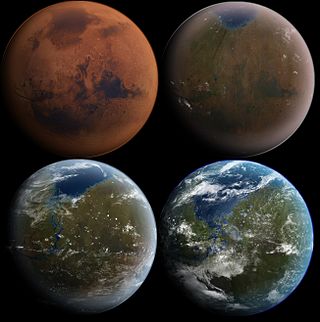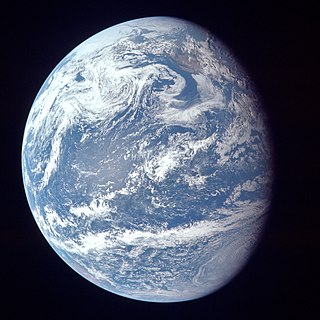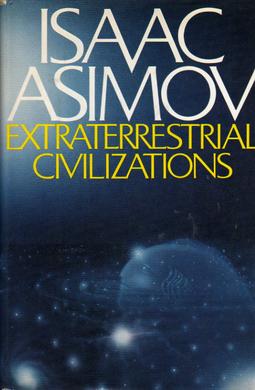Related Research Articles

Astrobiology is a scientific field within the life and environmental sciences that studies the origins, early evolution, distribution, and future of life in the universe through investigating its deterministic conditions and contingent events. As a discipline, astrobiology is founded on the premise that life may exist beyond Earth.

Hypothetical types of biochemistry are forms of biochemistry agreed to be scientifically viable but not proven to exist at this time. The kinds of living organisms currently known on Earth all use carbon compounds for basic structural and metabolic functions, water as a solvent, and DNA or RNA to define and control their form. If life exists on other planets or moons it may be chemically similar, though it is also possible that there are organisms with quite different chemistries – for instance, involving other classes of carbon compounds, compounds of another element, or another solvent in place of water.

Extraterrestrial life, colloquially referred to as alien life, is life that may occur outside of Earth and which did not originate on Earth. No extraterrestrial life has yet been conclusively detected, although efforts are underway. Such life might range from simple forms like prokaryotes to intelligent beings, possibly bringing forth civilizations that might be far more advanced than humankind. The Drake equation speculates about the existence of sapient life elsewhere in the universe. The science of extraterrestrial life is known as astrobiology.

Isaac Asimov was an American writer and professor of biochemistry at Boston University. During his lifetime, Asimov was considered one of the "Big Three" science fiction writers, along with Robert A. Heinlein and Arthur C. Clarke. A prolific writer, he wrote or edited more than 500 books. He also wrote an estimated 90,000 letters and postcards. Best known for his hard science fiction, Asimov also wrote mysteries and fantasy, as well as much non-fiction.

Terraforming or terraformation ("Earth-shaping") is the hypothetical process of deliberately modifying the atmosphere, temperature, surface topography or ecology of a planet, moon, or other body to be similar to the environment of Earth to make it habitable for humans to live on.
Xenoarchaeology, a branch of xenology dealing with extraterrestrial cultures, is a hypothetical form of archaeology that exists mainly in works of science fiction. The field is concerned with the study of the material remains to reconstruct and interpret past life-ways of alien civilizations. Xenoarchaeology is not currently practiced by mainstream archaeologists due to the current lack of any material for the discipline to study.
Mesoplanets are planetary-mass objects with sizes smaller than Mercury but larger than Ceres. The term was coined by Isaac Asimov. Assuming size is defined in relation to equatorial radius, mesoplanets should be approximately 500 km to 2,500 km in radius.

Planetary habitability is the measure of a planet's or a natural satellite's potential to develop and maintain environments hospitable to life. Life may be generated directly on a planet or satellite endogenously or be transferred to it from another body, through a hypothetical process known as panspermia. Environments do not need to contain life to be considered habitable nor are accepted habitable zones (HZ) the only areas in which life might arise.

An ocean world, ocean planet, panthalassic planet, maritime world, water world or aquaplanet, is a type of planet that contains a substantial amount of water in form of oceans, either beneath the surface, as subsurface oceans, or on the surface with a hydrosphere, potentially submerging all dry land. The term ocean world is also used sometimes for astronomical bodies with an ocean composed of a different fluid or thalassogen, such as lava, ammonia or hydrocarbons like on Titan's surface.

Planetary chauvinism is the belief that human society will always be planet-based, and overlooks or ignores the potential benefits of space-based living. The idea can be extended to alien society in general. That is, we should expect alien society to be planet based. The coining of the term is often credited to Isaac Asimov, but in an interview with Bill Boggs, Asimov mentions that he heard it from Carl Sagan. The counter-argument is that all the benefits of a planet can be achieved in space, usually by an O'Neill cylinder-type structure.

Whether there is life on Titan, the largest moon of Saturn, is currently an open question and a topic of scientific assessment and research. Titan is far colder than Earth, but of all the places in the Solar System, Titan is the only place besides Earth known to have liquids in the form of rivers, lakes, and seas on its surface. Its thick atmosphere is chemically active and rich in carbon compounds. On the surface there are small and large bodies of both liquid methane and ethane, and it is likely that there is a layer of liquid water under its ice shell. Some scientists speculate that these liquid mixes may provide prebiotic chemistry for living cells different from those on Earth.
This glossary of chemistry terms is a list of terms and definitions relevant to chemistry, including chemical laws, diagrams and formulae, laboratory tools, glassware, and equipment. Chemistry is a physical science concerned with the composition, structure, and properties of matter, as well as the changes it undergoes during chemical reactions; it features an extensive vocabulary and a significant amount of jargon.

The habitability of natural satellites is a measure of their potential to sustain life in favorable circumstances. Habitable environments do not necessarily harbor life. Natural satellite habitability is a new area that is significant to astrobiology for various reasons, the most important of which being that natural satellites are expected to outnumber planets by a large margin, and it is projected that habitability parameters will be comparable to those of planets. There are, nevertheless, significant environmental variables that affect moons as prospective alien life locations. The strongest candidates for natural satellite habitability are currently icy satellites such as those of Jupiter and Saturn—Europa and Enceladus respectively, although if life exists in either place, it would probably be confined to subsurface habitats. Historically, life on Earth was thought to be strictly a surface phenomenon, but recent studies have shown that up to half of Earth's biomass could live below the surface. Europa and Enceladus exist outside the circumstellar habitable zone which has historically defined the limits of life within the Solar System as the zone in which water can exist as liquid at the surface. In the Solar System's habitable zone, there are only three natural satellites—the Moon, and Mars's moons Phobos and Deimos —none of which sustain an atmosphere or water in liquid form. Tidal forces are likely to play as significant a role providing heat as stellar radiation in the potential habitability of natural satellites.

Extraterrestrial Civilizations is a 1979 book by Isaac Asimov, in which the author estimates the probability of there being intelligent extraterrestrial civilizations within the Milky Way galaxy. This estimation is approached by progressively analyzing the requirements for life to exist.

The Left Hand of the Electron is a collection of seventeen nonfiction science essays by American writer and scientist Isaac Asimov, first published by Doubleday & Company in 1972. It was the ninth of a series of books collecting essays from The Magazine of Fantasy and Science Fiction. The title comes from the topic of the first section which deals with chirality of electroweak interactions and chirality of organic compounds and the possible connection between the two. Other essays in this book concern the effect of electron-spin direction on molecular structure e.g. the "Inverse Sugar" in honey with philosophical reflections on the minority of left handedness in general.
Interplanetary contamination refers to biological contamination of a planetary body by a space probe or spacecraft, either deliberate or unintentional.

A planetary surface is where the solid or liquid material of certain types of astronomical objects contacts the atmosphere or outer space. Planetary surfaces are found on solid objects of planetary mass, including terrestrial planets, dwarf planets, natural satellites, planetesimals and many other small Solar System bodies (SSSBs). The study of planetary surfaces is a field of planetary geology known as surface geology, but also a focus of a number of fields including planetary cartography, topography, geomorphology, atmospheric sciences, and astronomy. Land is the term given to non-liquid planetary surfaces. The term landing is used to describe the collision of an object with a planetary surface and is usually at a velocity in which the object can remain intact and remain attached.
The cultural impact of extraterrestrial contact is the corpus of changes to terrestrial science, technology, religion, politics, and ecosystems resulting from contact with an extraterrestrial civilization. This concept is closely related to the search for extraterrestrial intelligence (SETI), which attempts to locate intelligent life as opposed to analyzing the implications of contact with that life.

A gas giant is a giant planet composed mainly of hydrogen and helium. Gas giants are also called failed stars because they contain the same basic elements as a star. Jupiter and Saturn are the gas giants of the Solar System. The term "gas giant" was originally synonymous with "giant planet". However, in the 1990s, it became known that Uranus and Neptune are really a distinct class of giant planets, being composed mainly of heavier volatile substances. For this reason, Uranus and Neptune are now often classified in the separate category of ice giants.
Planetary oceanography also called astro-oceanography or exo-oceanography is the study of oceans on planets and moons other than Earth. Unlike other planetary sciences like astrobiology, astrochemistry and planetary geology, it only began after the discovery of underground oceans in Saturn's moon Titan and Jupiter's moon Europa. This field remains speculative until further missions reach the oceans beneath the rock or ice layer of the moons. There are many theories about oceans or even ocean worlds of celestial bodies in the Solar System, from oceans made of diamond in Neptune to a gigantic ocean of liquid hydrogen that may exist underneath Jupiter's surface.
References
- 1 2 Robert A. Freitas Jr., Xenology: An Introduction to the Scientific Study of Extraterrestrial Life, Intelligence, and Civilization, First Edition, Xenology Research Institute, Sacramento, CA, 1979; http://www.xenology.info/Xeno.htm
- 1 2 Committee on the Limits of Organic Life in Planetary Systems, Committee on the Origins and Evolution of Life, National Research Council. The Limits of Organic Life in Planetary Systems. National Academies Press (2007)
- ↑ Isaac Asimov, The Thalassogens, The Magazine of Fantasy and Science Fiction, December 1970, ed. Edward L. Ferman, publ. Mercury Press, Inc., $0.60,
- ↑ Isaac Asimov, The Left Hand of the Electron, Doubleday, 0-385-04345-7, 225pp, 1972
- ↑ Bains, William (June 2004). "Many chemistries could be used to build living systems". Astrobiology. 4 (2): 137–67. Bibcode:2004AsBio...4..137B. doi:10.1089/153110704323175124. PMID 15253836.